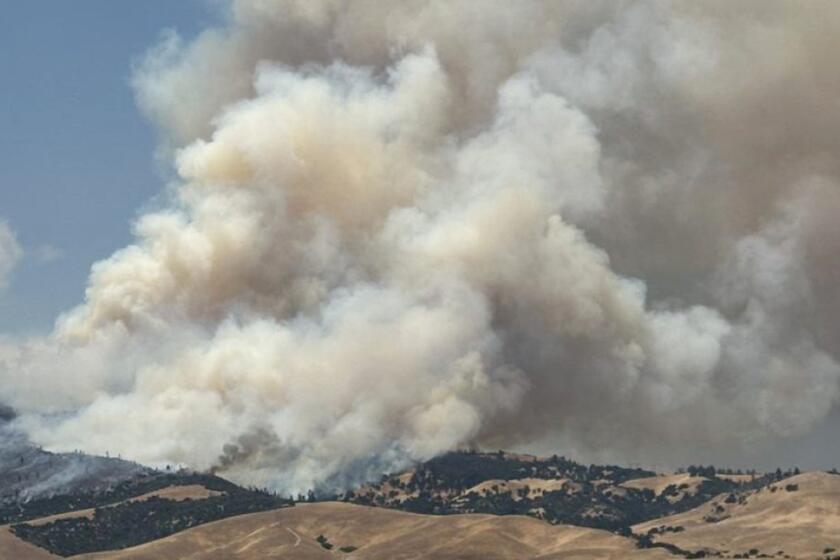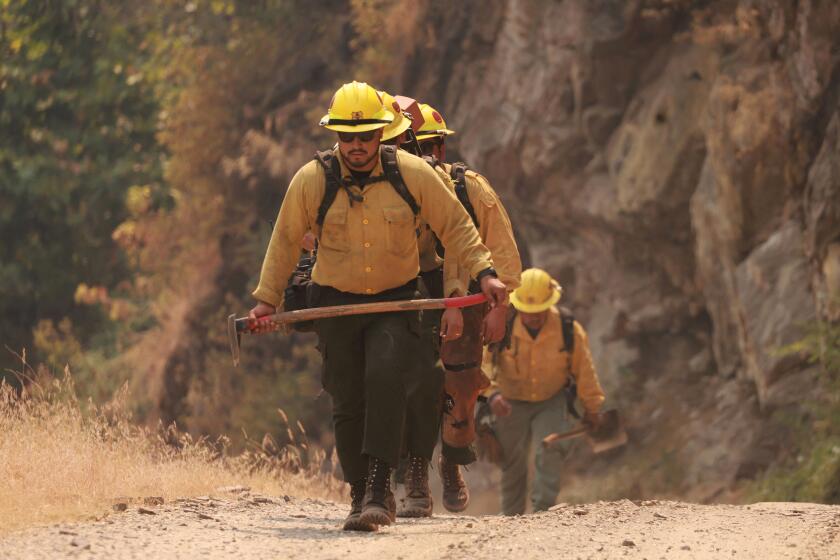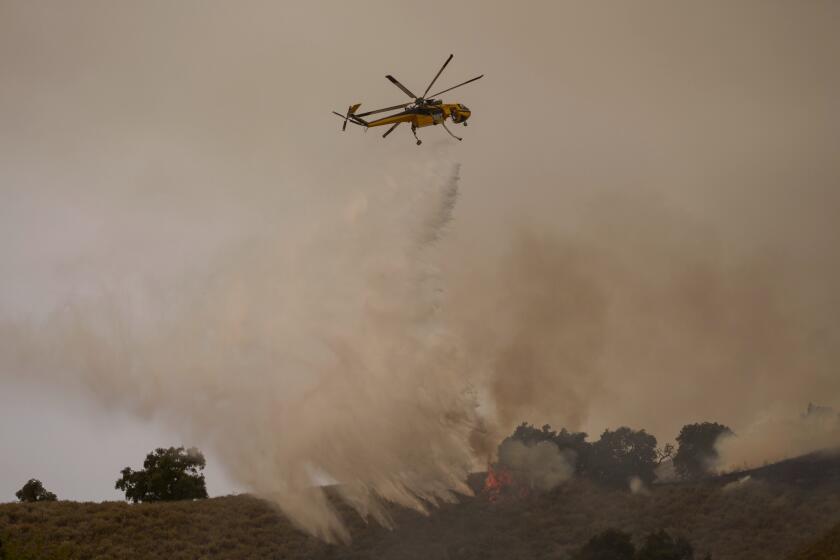A perfect recipe for a blaze
No one could claim surprise last week when tall flames raged across more than 3,000 acres and consumed 254 homes.
The ingredients for a devastating wildfire have long been in place in the Tahoe Basin, one of the West’s most popular forest playgrounds, where 32,000 houses are tucked into an overgrown forest of pine and fir and 3 million visitors a year come to relax on the shores of one of the deepest and clearest lakes in the world.
Heavy logging in the 1800s followed by dense regrowth and a century of fire suppression thwarted the basin’s natural wildfire cycle and helped turn the area into a tinderbox.
Efforts to reduce the fire hazard, underway for more than a decade, were slowed by an early shortage of funding and some public resistance to extensive tree cutting.
The Angora fire has taught emergency planners a grim lesson. Even textbook precautions can go up in flames, if the fire is hot enough and the winds are strong.
“This fire was the absolute worse-case nightmare we feared,” said Julie Regan, communications and legislative affairs chief for the Tahoe Regional Planning Agency, a powerful bi-state agency that became a magnet for blame last week as irate residents insisted that the organization’s strict environmental regulations had interfered with forest thinning that could have protected their homes.
Although some local officials said the agency’s erosion control requirements have made it harder to get approval for thinning, agency rules did not stop thinning on public lands bordering the burned subdivision.
The U.S. Forest Service, which manages most of the land in the basin, had thinned some 3,000 acres in and around the burned area during the last eight years, including a just-completed project.
“In this particular situation, probably not a whole lot of anything would have stopped this fire from devastating the small subdivision it burned,” said Dave Marlow, the vegetation, fire and fuels manager for the U.S. Forest Service’s Lake Tahoe Basin Management Unit.
The thinning, which removes dense brush and tree growth, slowed the flames but could not halt them as they were driven into treetops by dry, strong winds more characteristic of Southern California than of the alpine slopes of the Sierra Nevada.
The fire broke out June 24 in 30-mph gusts at the south end of the lake after two days of 5% humidity. The Forest Service said Friday evening that a campfire had caused the blaze.
The thinning projects, Marlow said, “are designed for average weather and fire conditions, and when this fire broke out we had extreme fire weather.” Still, he added, the thinning work “really helped in terms of keeping losses down. It could have been worse.”
At Tahoe, conditions that have primed much of the Sierra range for major wildfires are writ large.
In the mid-1800s, two-thirds of the basin was stripped of most of its trees as loggers felled timber for the nearby Comstock Lode mines. When the forest grew back in the 20th century, it rose from the slopes thick and roughly the same age and height -- perfect food for a fire.
In the early 1900s, the federal government adopted an anti-fire policy on public lands throughout the country, snuffing out forest blazes as fast as it could.
For nearly a century, that approach blocked the natural cycle of frequent low-intensity fires that in the past had helped clean out dense young growth in the basin.
Adding to the flammable mix were tens of thousands of homes built amid the trees after World War II.
Today, steep hillside neighborhoods are filled with alpine-style houses with wood shake roofing, wood decks, yards covered with wood chips or pine needles, all surrounded by big trees. Hotels and business adopt a log-cabin look.
“The reality is that there has been unanimity for more than a decade now for the need for thinning,” said Rochelle Nason, executive director of the League to Save Lake Tahoe, a local environmental group.
But it was slow getting started. About 21,000 acres of federal, private and state land have been thinned in the basin in the last decade, according to Regan. But 67,000 more acres need treatment.
Forest Service spokesman Matt Mathes said that in the last 10 years, not a single environmental appeal or lawsuit was filed against Forest Service thinning projects in the basin, but not everyone was thrilled to see chain saws in action.
“The people of Lake Tahoe did not move there to have a view of a timber-cutting operation,” Mathes said. “And the funding was not there.”
Further complicating matters is the strict environmental oversight of the regional planning agency, created in 1969 to control development in the basin and stop the runoff and pollution that were robbing the lake of its famed clarity.
Controversial from its inception, the agency has greatly limited growth and not been shy about telling property owners what they can and cannot do on their land.
To prevent eroding soil from washing into the lake’s cobalt waters, the agency requires homeowners to maintain ground cover -- which can be mulch or pine needles -- beyond a 5-foot clearing immediately around their houses.
If residents want to cut down live trees with trunks larger than 6 inches in diameter on a lot, they have to get a permit. Removing trees to improve the view is not allowed.
“They actually tell people to put dry pine needles around their yards and try to talk people out of cutting trees,” Dale Kanter complained last week as he sat in an espresso shop with a small white dog on his lap.
Kanter, who has lived in the basin more than 30 years, said the agency was “at least partly to blame” for the fire that was burning a few miles away.
Marlow, the Forest Service’s federal fuels manager, said that as long as pine needles were not piled next to a house, he did not believe that they posed a problem for firefighters.
Regan said her regional agency would take another look at the issue.
Mike Weber, South Lake Tahoe mayor pro tem, cited a proposed thinning project that has prompted concerns from water quality officials on the Tahoe Regional Planning Agency’s board because it would use an abandoned Forest Service road that crosses part of a sensitive stream area.
“What’s been happening is a delay in implementation, and that’s been hurting us,” he said.
Forest Service relations with the planning agency have improved in recent years, Mathes said. “We don’t fully buy in to the criticism” of the agency.
Still, he said meeting the agency’s environmental requirements drives up the cost of thinning, which is expensive to begin with in the basin because terrain is often steep, without roads or near houses.
Work that would typically cost $600 to $1,000 an acre in many of California’s national forests costs $1,500 to $2,000 in the basin, Mathes said.
Much of the thinning has to be done with chain saws rather than with heavy equipment.
The high cost of basin projects has made funding needs all the more acute.
“I think the problem has been money,” said Robert McDowell, a retired forester who spent most of his U.S. Forest Service career working in the basin. He served for a number of years on the regional planning agency’s advisory board and is chairman of his neighborhood fire council chapter on the Nevada side of the lake.
The funding prospects have greatly improved as a result of 2003 legislation that is funneling money to the basin from booming federal land sales in the Las Vegas area.
The Forest Service got $10 million last year and will receive the same amount this year for thinning projects. It plans to speed up the pace of fuels reduction work to 4,200 acres a year for the next decade.
“We see better days ahead,” Mathes said.
Cost has also been an issue for homeowners, who must typically spend between $1,000 and $4,000 to remove closely packed trees from their lots. Marlow recalled watching one neighborhood operation that required a crane.
“They would literally reach over the house with a crane, cut the tree and lift the tree over the house” so it wouldn’t topple onto the roof.
There are government grants available to homeowners. Residents of McDowell’s Chimney Rock neighborhood have used them to help pay for thinning on more than 100 properties.
But not everyone is lining up. “We’ve had a couple of people who object to cutting any trees -- period,” McDowell said.
Vacation properties, which make up about 40% of the houses in McDowell’s area, are another challenge.
“Second-home owners are kind of less interested than the people who live here every day,” he said.
“We haven’t found the key to get their attention yet.”
Moreover, it’s an ongoing chore to control flammable growth.
“With a forest, when you do defensible space around your home, it’s a forever project,” said Wayne Fischer, who lives in Incline Village, an affluent community on the Nevada side of the lake that has been a leader in fire hazard reduction.
The fire protection district of that 8,000-home community employs 40 seasonal workers to clear fuels every summer at a cost of more than $1.5 million a year. More than half the cost is paid by fire prevention grants, along with income the crew brings in from fighting fires in the Sierra. The rest is covered by local taxes.
But no amount of work will fire-proof the basin.
“I think realistically any home in the woods is always at risk,” said Marlow, the Forest Service manager. “That’s a choice you make when you live in the woods.”
--
julie.cart@latimes.com
More to Read
Start your day right
Sign up for Essential California for news, features and recommendations from the L.A. Times and beyond in your inbox six days a week.
You may occasionally receive promotional content from the Los Angeles Times.








